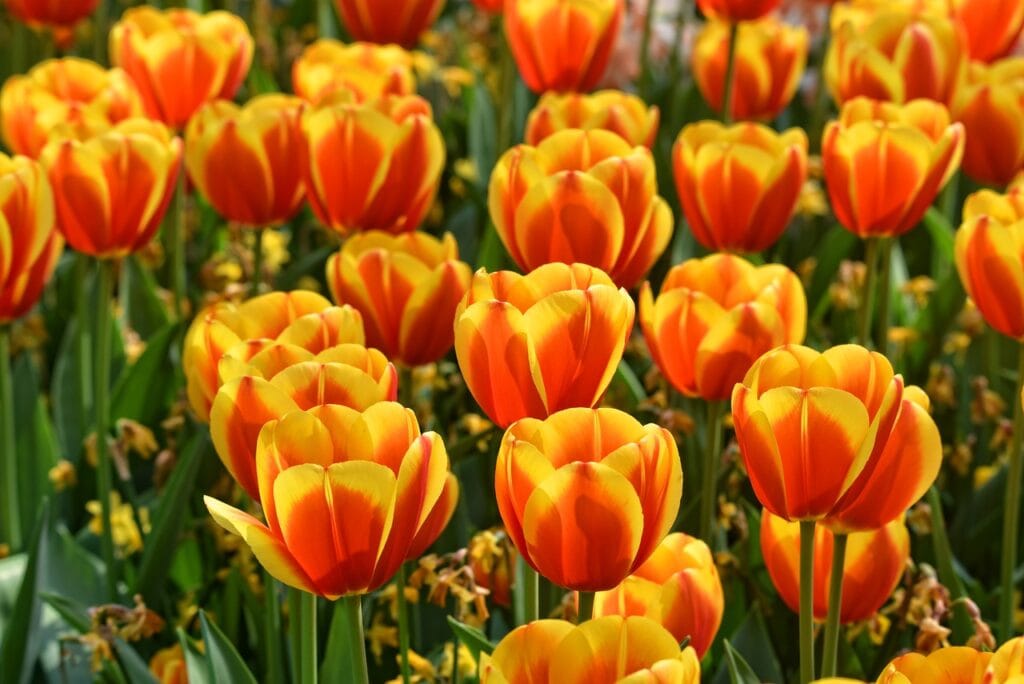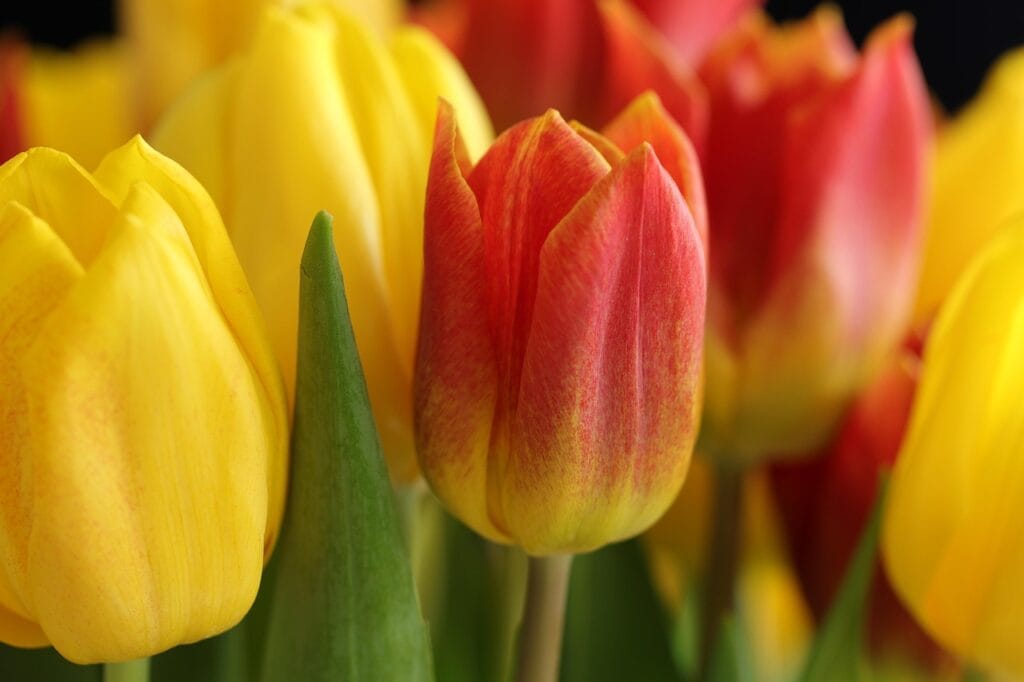Thinking about growing tulips in your garden but not sure where to start? You’re not alone. A lot of people wonder how to care for tulips, especially if they’re new to home gardening.
The good news? It’s not as complicated as it might seem.
In this guide, we’ll walk through everything you need to know to help your tulips thrive—like when and where to plant them, how deep tulip bulbs should go into the ground, how often to water, what to do once they bloom, and even how to move them around if needed.
You’ll also get tips to avoid the most common tulip-growing mistakes (yep, we’ve made ’em too), plus answers to questions like why your tulips aren’t blooming or how to keep squirrels from digging up your bulbs.
Ready to get your hands a little dirty and grow some stunning tulips? Let’s do this.
Understanding Tulips: A Quick Overview
Before we get into the nitty-gritty of how to care for tulips, let’s get a handle on what we’re actually working with.
Tulips are spring-blooming perennials that grow from bulbs—not seeds.
They’re originally from Central Asia but became wildly popular in the Netherlands (you’ve probably seen those iconic tulip fields).
Today, they’re loved worldwide and come in over 3,000 varieties, with just about every color you can think of—except true blue.
Most tulips bloom in early to mid-spring, depending on the type. There are early, mid, and late-season varieties, which means with the right planning, you can have blooming tulips for up to 6 weeks. Pretty sweet, right?
Now, let’s talk hardiness zones. Tulips generally do best in USDA zones 3 through 8. If you’re in Canada, the UK, or Australia, the rule of thumb is to give them a cold period (more on that later).
Tulips need that winter chill to “wake up” and bloom in spring. No chill = no flowers.
And nope, not all tulips are the same. Some are short and sturdy (perfect for windy spots), while others are tall and dramatic—great for flower beds or cutting gardens.
There are fringed tulips, parrot tulips, Darwin hybrids, and even ones that look like peonies.
So before you plant, figure out what kind of vibe you’re going for and what your climate allows. Knowing your tulip types makes everything else—planting, caring, and troubleshooting—a lot easier.
You may also like:
- Popular Flower Types: 8 Top Picks for Home Gardens
- How to Care for Poinsettias: The Ultimate Guide for Healthy Holiday Blooms
- How to Care for Ponytail Palm: The Ultimate Guide for Beginners
When and Where to Plant Tulip Bulbs


Timing is everything when it comes to tulips. If you want a big spring show, you’ve got to think ahead—tulip bulbs are planted in fall, not spring.
Yep, you read that right. They need several weeks of cold to trigger blooming.
So in the U.S., Canada, and the UK, that usually means planting between late September and early November.
If you’re in Australia or a warmer climate, you might need to pre-chill the bulbs in the fridge (not the freezer!) for about 10–12 weeks before planting.
Let’s talk location. Tulips love the sun. Aim for a spot that gets at least 6 hours of direct sunlight daily.
They don’t like soggy soil though, so drainage is key. If water tends to sit in your garden bed, fix that first—either by raising the bed or mixing in some coarse sand or compost to help with drainage.
Also, try not to plant them too close to trees or shrubs. Tulip bulbs don’t want to compete with thirsty roots, and they need the full sun exposure that open areas provide.
A garden border, a front yard bed, or even containers on a patio can all work if the light and soil are right.
If you want a truly showy look, plant them in clusters instead of rows. Think natural patches or drifts of 10–15 bulbs grouped together—it looks more organic and gives you better color impact.
Bottom line? For tulips to do their thing, they need a cold start, full sun, and well-drained soil. Nail those three, and you’re off to a solid start.
You may also like:
- How to Care for Succulents: Complete Beginner’s Guide
- How to Make Orchids Bloom: A Complete Guide for Home Gardeners
How Deep Are Tulip Bulbs Planted?
This is one of the most common questions when figuring out how to care for tulips—and it’s a good one. Planting depth really does matter.
Here’s the general rule: tulip bulbs should go about 6 to 8 inches deep, measured from the base of the bulb to the soil surface.
If you’re in a colder climate, aim for the deeper end (closer to 8 inches) to protect the bulbs from freezing. Warmer climate? Around 6 inches is fine.
Spacing also matters. Leave about 4 to 6 inches between each bulb. That gives them enough room to grow without competing for nutrients and water.
If you’re planting a ton of them in a big bed, don’t stress too much about exact spacing—just don’t pack them in too tight.
Make sure you plant them pointy side up. The flat side goes down—that’s where the roots come out.
If you accidentally plant a few upside down, it’s not the end of the world (they might still grow), but planting them correctly gives you a much better success rate.
Pro tip: loosen the soil before planting, and if it’s heavy or clay-like, mix in compost or sand to help with drainage. You don’t want the bulbs to sit in wet, compacted soil—that’s a fast track to rot.
A hand trowel works for small batches, but if you’re planting a lot, get a bulb planter or auger attachment for your drill. Your back will thank you.
You may also like:
Watering and Feeding Tulips


Alright, let’s get into one of the trickiest parts of how to care for tulips: watering. It’s easy to overdo it—especially if you’re used to fussing over your plants.
Here’s the deal: tulips don’t like soggy soil. Too much water and the bulbs will rot.
When you first plant them in the fall, give them a good soak to help settle the soil and start root development. After that? You can leave them alone. Fall and winter rains usually do the job.
In spring, once you start seeing green shoots pop up, it’s time to pay a little more attention.
If there’s no rain for more than a week or so, give them a drink—about 1 inch of water per week is enough. Stick your finger into the soil to check—if it’s still moist a couple inches down, you’re good.
Now about feeding: tulips don’t need a lot, but they do appreciate a little boost.
Mix a slow-release, low-nitrogen fertilizer into the soil when planting. Bone meal or a bulb-specific fertilizer works great. Just skip the high-nitrogen stuff—that encourages leaf growth but not flowers.
If you want to feed again in early spring, do it when the leaves are just a few inches tall—not once they’ve already bloomed.
After blooming, they’re storing energy in the bulb for next year, so that’s when they need strong roots, not extra leaves.
Quick don’ts:
- Don’t fertilize after the leaves start dying back.
- Don’t water if the soil’s already wet.
- Don’t sprinkle fertilizer directly on the bulb—it can burn it.
Think of tulips like chill houseguests: give them what they need upfront, and they’ll take care of the rest.
You may also like:
Seasonal Tulip Care (Spring to Winter)
Now that you’ve got your tulips in the ground and growing, let’s talk about what to do with them throughout the year.
Yep, how to care for tulips isn’t just a “plant and forget” situation—it changes a bit with the seasons.
Spring (Bloom Time)
This is when all your fall prep pays off. You’ll start to see green shoots, then buds, and finally those bright, colorful flowers.
During this time, make sure your tulips get enough sunlight and water (but not too much). If you’ve got a dry spring, water them once a week. No need to fertilize now if you already did it earlier.
Don’t cut the leaves or stems right after blooming. It’s tempting, but the leaves need to stay on so they can keep photosynthesizing—that’s how the bulb gets energy for next year’s flowers.
Late Spring / Early Summer (Post-Bloom)
Once the petals fall off, you can remove the flower heads (aka deadheading) to stop the plant from wasting energy on seed production.
But leave the leaves in place until they turn yellow and die back naturally. It’s not the prettiest phase, but it’s super important.
Some gardeners tuck tulips behind low-growing plants like hostas or ground covers so the dying foliage isn’t front and center.
Fall and Winter
In cooler climates, tulips go dormant in summer and “rest” underground. If your winters are cold, just leave them in the ground—nature’s got it handled.
In warmer zones where winters don’t get cold enough (looking at you, some parts of California and Australia), you’ll want to dig up the bulbs in summer, chill them in the fridge for 10–12 weeks, and replant in fall.
Mulching lightly in fall helps regulate soil temps and keeps weeds down, but don’t overdo it—bulbs don’t like staying damp.
Tulips are surprisingly low-maintenance if you understand their cycle. Respect the nap, and they’ll keep coming back strong.
You may also like:
Transplanting and Dividing Tulips


Alright, let’s say your tulips have been doing their thing for a few years, but now they’re looking a bit… tired.
Fewer blooms, crowded leaves, just kind of meh.
That’s your cue—it’s time to dig them up. Learning how to care for tulips also means knowing when (and how) to transplant and divide them.
When to Lift Tulip Bulbs
You’ll want to dig up tulip bulbs after the foliage has completely died back—usually late spring to early summer. That’s when the plant has finished feeding the bulb for next year and gone dormant.
Don’t rush this step. If you lift them too early, they might not bloom again.
In cooler climates, you can actually leave them in the ground for several seasons. But if you notice overcrowding or want to move them around, lifting is a good idea.
How to Dig, Store, and Replant
Use a garden fork or spade and dig around the bulb gently to avoid damaging it. Once lifted, shake off excess soil and inspect the bulbs. Toss any that are mushy, moldy, or shriveled.
Let the healthy ones dry in a shaded, well-ventilated spot for a few days. Then, store them in a mesh bag or paper bag (no plastic—it traps moisture) in a cool, dry place until fall. Label them if you’ve got multiple varieties—it’s easy to forget.
When replanting in fall, follow the same depth and spacing rules we talked about earlier.
Dividing for More Blooms
Sometimes you’ll find smaller bulbs attached to the main one—these are called “offsets.” You can gently break them apart and plant them separately.
They might take a year or two to bloom, but they’ll eventually catch up. Free tulips? Yes, please.
Transplanting and dividing isn’t hard—it’s just a bit of garden maintenance that keeps your tulip patch strong and blooming beautifully year after year.
Common Tulip Problems and How to Fix Them
Even when you do everything right, things can go sideways. Knowing how to care for tulips also means being ready for some of the usual suspects—pests, diseases, and just plain weird tulip behavior.
Pests That Love Tulips (Unfortunately)
- Aphids: These tiny bugs suck the sap from stems and leaves. You might notice sticky residue or distorted growth. A quick blast of water or neem oil usually does the trick.
- Slugs and snails: These guys go for young shoots and leaves. Set up a beer trap or sprinkle crushed eggshells around the base to keep them off.
- Squirrels and rodents: They’ll dig up your bulbs like it’s a game. Try laying chicken wire over the soil after planting, or use natural repellents like blood meal.
Diseases to Watch Out For
- Tulip Fire (Botrytis tulipae): Sounds dramatic, and it kind of is. It causes brown spots on leaves and petals and makes the whole plant look like it got scorched. If you see it, remove the infected plant immediately—don’t compost it.
- Bulb rot: This usually happens when bulbs sit in wet soil. You’ll know something’s off if tulips don’t emerge in spring or the bulb smells funky when dug up. Prevention is key—plant in well-drained soil and don’t overwater.
Other Odd Tulip Issues
- Yellow leaves early in the season? Could be poor soil or overcrowding.
- No blooms at all? Maybe the bulbs didn’t get cold enough over winter, or they’re just too old and need replacing.
- Floppy tulips? They might be reaching for sun or growing in too-rich soil.
A lot of tulip problems are easy to handle once you know what to look for. Stay observant, fix what you can, and don’t stress too much—tulips are tougher than they look.
Bonus Tips for Thriving Tulip Gardens


You’ve got the basics of how to care for tulips, but if you’re ready to level up your garden game, these extra tips can make a big difference.
A few small choices can turn “pretty tulips” into “whoa, where’d you learn to garden?!”
Try Companion Planting
Tulips look great on their own, but pairing them with other plants adds texture and extends interest. Good companions include:
- Hyacinths and daffodils (they bloom at the same time)
- Pansies or violas (perfect for underplanting)
- Hostas or ferns (these hide fading tulip leaves later in the season)
Just make sure whatever you plant nearby also likes full sun and well-drained soil.
Mix Tulip Varieties
Want longer bloom time? Mix early, mid, and late-season tulips in the same bed. They’ll take turns blooming, giving you color for weeks instead of days.
Just remember to space them properly—cramming too many bulbs together leads to weak growth.
Naturalize for a Wild Look
If you’ve got a semi-wild spot in your yard, try naturalizing tulips. This means planting them in a more scattered, random pattern—like they just showed up there on their own.
It works especially well with species tulips, which tend to come back better each year than hybrids.
And if you’re working with containers or raised beds, go bold with color combos. Tulips don’t mind being in pots as long as they get their chill time and decent drainage.
Bottom line? Don’t be afraid to experiment. Tulips are flexible, and they look amazing when you play around with variety, placement, and companion plants. It’s your garden—make it yours.
Conclusion
So, how to care for tulips? It all comes down to a few key things: plant them in the fall, give them a cold rest, make sure the soil drains well, don’t overwater, and let the leaves die back naturally after blooming.
That’s it. Seriously.
Tulips don’t need a ton of maintenance—they just need you to understand how they work.
Once you get the rhythm of their yearly cycle, they’re actually super easy to grow.
And when they bloom? It’s totally worth the wait.
If you stick to what we’ve covered—planting at the right time and depth, avoiding soggy soil, feeding them right, and dealing with pests before they become a problem—you’ll be looking at a garden full of bright, happy tulips every spring.
Got the tulip bug now? Good. There’s more beauty to grow.
If you’re into tulips, you’re probably gonna love roses too. They’re a bit different to grow, but just as rewarding—and yeah, they totally steal the show when they’re in full bloom.
Check out our complete guide on how to grow and care for roses for everything you need to know: planting, pruning, keeping pests away, and getting those big, bold blooms.
FAQ: How to Care for Tulips
1. Can I plant tulip bulbs in spring?
Not ideal. Tulip bulbs need a cold period to bloom. Plant them in fall, or chill them in the fridge for 10–12 weeks before planting if you’re late.
2. How deep should tulip bulbs be planted?
Around 6 to 8 inches deep, with the pointy end facing up. Deeper is better in colder climates to protect from frost.
3. How often should I water tulips?
Water once after planting, then leave them alone until spring. During the growing season, water only if the soil is dry about an inch down.
4. Why aren’t my tulips blooming?
Could be old or overcrowded bulbs, not enough chill time, or poor soil. Also, don’t cut the leaves too early—they feed next year’s bloom.
5. Can I leave tulip bulbs in the ground year-round?
Yes, in colder climates with well-drained soil. In warmer areas, lift and chill them over summer, then replant in fall.
6. How do I keep squirrels from digging up my bulbs?
Use chicken wire over your planting bed, sprinkle blood meal, or plant bulbs deeper than 6 inches to discourage digging.




